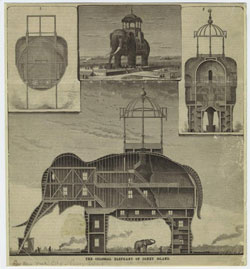 The history of Margate City as a populated community does not go back quite as far as some other Jersey Shore locations. Located on Absecon Island just over 5 miles from what is now Atlantic City, the land that would become Margate City was full of snakes and thick, dense brush that made it less than an ideal choice for settlers. Even the Delaware Indians, who often visited the area, never chose to permanently settle there.
The history of Margate City as a populated community does not go back quite as far as some other Jersey Shore locations. Located on Absecon Island just over 5 miles from what is now Atlantic City, the land that would become Margate City was full of snakes and thick, dense brush that made it less than an ideal choice for settlers. Even the Delaware Indians, who often visited the area, never chose to permanently settle there.
While the first settler to the land would not come until the early 19th century, some of the island’s land was purchased by a developer in 1695. Thomas Bud wanted to purchase some land on the mainland off of which Absecon Island was located. In order to get the best deal, he also had to purchase some land on the island. Bud had no use for the land, but in order to get a good deal on the land he wanted, he agreed to buy some land on the island for about 4 cents per acre.
The first settler, Hezediadiah Samson, came more than 100 years later. Samson was a fisherman and a farmer. He settled on the island during the War of 1812. He had a worker who had deserted from the military and Samson helped to hide this man, William Day. Day lived in a cave in what is now Margate City. He and Samson had worked out a signal so that Day would know when it was safe to leave his dwelling place. At the end of the war, Day turned himself in.
Another early settler was John Bryan. He built a home on the island and managed the life saving station. He also took charge of items that washed ashore following shipwrecks off of the coast. He made his living by operating a salt plant.
By the mid-19th century, there were more people living in what is now Margate City. Most who lived on the island provided goods and services to the many hunters and fisherman that would visit the region. While there were a few permanent settlers here by this point, it is an elephant that can be credited for helping Margate City become the popular destination that it is today.
James V. Lafferty was a Philadelphia man who had made his money in real estate. He wanted to sell plots of land on Absecon Island, but he knew he needed a gimmick in order to get buyers to come. He built a hotel and restaurant in the shape of a giant elephant. Given the nickname Lucy, this gimmick worked and buyers came and bought land on which they built their own businesses or summer homes.
Happily, Lucy has managed to survive the many storms that have rocked Margate City. The elephant was struck by lightning in 2006, and the tusks show a bit of damage from that strike. Today, she is designated as a National Historic Landmark, a distinction earned in 1976.
Just a few years after Lucy made her debut, Camden and Atlantic Railroad began providing service to the island. The easy access to the entire island helped to further spur growth to the area.
What is now Margate City was once a borough of South Atlantic City. In 1897, South Atlantic City became a free standing city. The name was changed in 1909 to Margate City as a nod to the English resort of Margate.
The eight mile long island on which Margate City rests is also home to Longport, Ventnor City and Atlantic City. Seeing the success and growth in the area, the mayor Atlantic City in 1929 made the offer to allow Margate City to become part of Atlantic City. Margate City officials declined the offer.
Over the years, as the rest of the Jersey Shore grew in popularity as a summer hot spot, so did Margate City. New businesses continued to open along the shore and more and more visitors descended on the little city by the bay.
Today, Margate City is a popular Jersey Shore destination. While there are just over 8,000 year round residents, thousands of tourists come each summer to enjoy the beach, the nightlife and to have their photograph taken with a certain elephant, which still stands proudly as a reminder of the short but colorful history of Margate City.